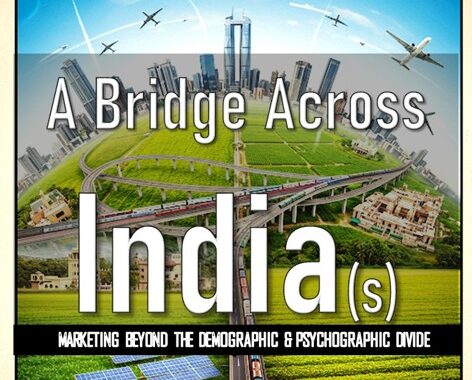Building Brands Brick by Brick…Literally!
 I was tuned into one of the local FM stations in Delhi as I was driving this morning and I encountered a virtual traffic jam. I changed at least three FM stations trying to catch a song and ran into the radio spots of popular developers in the Delhi NCR. Which is what set me thinking.
I was tuned into one of the local FM stations in Delhi as I was driving this morning and I encountered a virtual traffic jam. I changed at least three FM stations trying to catch a song and ran into the radio spots of popular developers in the Delhi NCR. Which is what set me thinking.We (at least those of us living in the top eight metros) are surrounded today by communication/messages from Real Estate as an industry. Be it television, print, radio, digital or outdoor they are everywhere. According to a recent report 22% of the AdEx comes the real estate industry Given that the you and me of the world are their TG and we seem to be getting exposed to all this communication someone somewhere must be doing their job right. Or is it?
What really is getting communicated to me is that there are lots of choices if I really were to buy property in and around Delhi. The choices indeed span taste and size of pocket. Which at most basis the textbook stages of building brand equity would fall in the awareness category. Push comes to shove, one might even be able to mention the names of a few builders (some brand managers would feel happy ticking of their ToM targets) hence there is some amount of brand recognition that the communication is delivering. Now comes the tricky part. The part that deals with creating a preference for the brand and then extending it into loyalty. Textbook!
Luxury The question in my mind though is whether this cookie-cutter approach works for brands in the real estate space? What really goes into building a brand in the real estate space? What role does the brand have to play in the process/decision of purchase?
For the sake of this discussion we shall look at those who set out to buy with the intention of inhabiting it or at best are looking for a secure investment. For the middle class, buying a house is not a simple decision. Unlike most other purchase decisions brands are not competing with other brands. They are competing with the process of purchase itself. If we were to take a look at what is competition for the brands whilst vying for consumer attention, the list would be long and for anyone who has gone through it, tiring. Starting from the point of realization i.e. “Yes! I/we need to buy a house” through the journey of information seeking, comparison, evaluation etc. the brand of the product which in this case is the house comes in very late into the equation. After going through the usual Where, What, When, How Big, How Much, What else do I get rigmarole the brand often is incidental.
So is there no point building brands in real estate? No, that is neither the import nor the message. The point is brand managers and agencies involved do not seem to be creating communication that is built on a complete understanding of the role of the brand. Most communication is dimensioned on price or the location or the amenities provided etc.
[youtube=http://www.youtube.com/watch?v=P3dzbW35_cM]
Brands in the real estate are in my opinion, built on one of the fundamental gauges of brand strength, trust. Here is a category where the past performance and future promise hold equal importance. The future is aspiration while the past is assurance. Every project that is completed is living testimony to how the brand fared on its time, cost and quality commitments. Every brick that gets laid is literally building the brand. Some of the better brands do talk about this but it usually is a passing mention and easy to miss.
For a sector that is the 2nd highest spender on media/advertising there was not a single real estate brand in the Top 100 of the Brand Equity Most Trusted Brands in India. In fact basis another report the first real estate brand appears at 516 in a list of Top 1200 brands! Of the ones that do appear, not all are into housing.
It is in building and communicating trust that real estate brands need to invest. Basis evidence they sure have a long way to go. Or should I say several floors to the top!
D(h)oomsday Prediction: The ABC of Movie Franchises
I admit! I am a cinemaholic and just so that we are clear; no I am not about to turn this thing into a movie review blog.
The world of cinema is replete with lessons in marketing. God knows many a trainers have borrowed freely from cinema to add that zing to their otherwise tardy workshops.
Came across an interesting article recently that was talking about some of the most successful movie franchises and that set me thinking. What better to write about on the eve of one of the most awaited releases of the year Dhoom3.
The brand manager in me always has a tough time convincing the product manager in me about a lot many things in general but the hardest tussle invariably is with regard to making lead horses out of product “specifications” instead of a product features or more importantly a product benefit.
A very senior colleague who was the Sr.VP while I was just a wet behind the ears management trainee learning product management ropes always used to insist on receiving a “FAB (Feature-Advantage-Benefit) Chart” along with every New Product communication.
He drilled into me (and boy am I thankful for it!) that a good product communication should Attract Attention to the product features, Build Interest around the advantages over a competing product and most importantly Convey Benefits of the experience of using/consuming the product.
How is that relevant to this conversation? Well, thats a conversation that the marketers of the Dhoom “franchise” haven’t seem to have had.
The success of the first in the series Dhoom was credited to the slick production, a pacy cops and robbers caper with bikes, babes and attitude thrown in. The actors were incidental. The second time around it was a heist again, a new robber and more eye candy for both men and women. It’s here that the product specs (read Hrithik Roshan) drew A LOT of attention and have led us to the topic at hand.
To open my argument I shall contrast the movie franchise with the iPad evolution.
The Apple conversations have always been at the benefit level. The first iPad was a category creator and we have seen Steve Jobs explain passionately about how the Pad fit into this gap between the smartphone and the laptop! The iPad 2 got FaceTime into the equation and now the iPad Air. The specifications of the latest launch iPad Air…. A7 chip with 64-bit architecture and M7 motion coprocessor. 9.7inch display with 2048×1536 resolution at 264 pixels per inch 7.5mm thin, 469gms etc etc.
Ask any geek and they would say these are kick-ass. While the folks at Apple have never ever compromised on the tech specs they almost always use them as incidental to their communication.This has helped them keep the aspiration levels of the brand intact as the comparison if any, with competition or a predecessor product is never at this level.All the buzz that has been created has been around Aamir Khan, the teasers concentrate on his look his part in the movie but fail to impress or generate any interest around the plot. Too much attention on the specifications. The followers of the series do not need to convinced about Aamir, what they need to be impressed about is how the plot has evolved and what they can expect when they walk into the cinema halls.
Sure there have been over 14.2Mn views on YouTube and theres a Dhoom 3 the game and that all the indicators are there for a rocking box office performance.The marketers at YRF have done their bit to get money in for Dhoom 3 but have they done a good job building Dhoom the brand and the franchise? I say no but then we’ll talk about that when and if there is a Dhoom 4.


